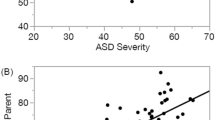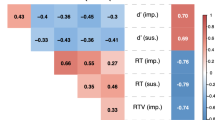Abstract
Academic attainment in children with Autism Spectrum Disorder (ASD) is under-studied, with associated factors largely undetermined. Parent-reported attention symptoms, attentional-switching and sustained-attention tasks were examined to determine relationships with mathematics and reading attainment in 124 children aged 7–12 years; sixty-four with high-functioning ASD, half girls, and sixty age- and gender-matched typical children (TYP). With full-scale IQ controlled there were no differences in mathematics, reading, attentional switching or sustained attention. In regression analysis, attentional switching was related to mathematics achievement in ASD but not TYP children. Findings highlight attentional switching difficulties are linked with poorer mathematics outcomes in ASD.
Similar content being viewed by others
References
American Psychiatric Association. (2000). Diagnostic and statistical manual of mental disorders, IV-TR. Washington, DC: American Psychiatric Association.
Ames, C., & Fletcher-Watson, S. (2010). A review of methods in the study of attention in autism. Developmental Review, 30(1), 52–73. doi:10.1016/j.dr.2009.12.003.
Asberg, J., Kopp, S., Berg-Kelly, K., & Gillberg, C. (2010). Reading comprehension, word decoding and spelling in girls with autism spectrum disorders (ASD) or attention-deficit/hyperactivity disorder (AD/HD): Performance and predictors. International Journal of Language & Communication Disorders, 45(1), 61–71. doi:10.3109/13682820902745438.
Ashburner, J., Ziviani, J., & Rodger, S. (2008). Sensory processing and classroom emotional, behavioral, and educational outcomes in children with autism spectrum disorder. American Journal of Occupational Therapy, 62(5), 564–573.
Ashburner, J., Ziviani, J., & Rodger, S. (2010). Surviving in the mainstream: Capacity of children with autism spectrum disorders to perform academically and regulate their emotions and behavior at school. Research in Autism Spectrum Disorders, 4(1), 18–27. doi:10.1016/j.rasd.2009.07.002.
Biederman, J., Monuteaux, M. C., Doyle, A. E., Seidman, L. J., Wilens, T. E., & Ferrero, F. (2004). Impact of executive function deficits and attention-deficit/hyperactivity disorder (ADHD) on academic outcomes in children. Journal of Consulting and Clinical Psychology, 72(5), 757–766. doi:10.1037/0022-006x.72.5.757.
Blair, C., & Razza, R. P. (2007). Relating effortful control, executive function, and false belief understanding to emerging math and literacy ability in kindergarten. Child Development, 78(2), 647–663. doi:10.1111/j.1467-8624.2007.01019.x.
Brereton, A. V., Tonge, B. J., & Einfeld, S. L. (2006). Psychopathology in children and adolescents with autism compared to young people with intellectual disability. Journal of Autism and Developmental Disorders, 36(7), 863–870. doi:10.1007/s10803-006-0125-y.
Brocki, K. C., Tillman, C. M., & Bohlin, G. (2010). CPT performance, motor activity, and continuous relations to ADHD symptom domains: A developmental study. European Journal of Developmental Psychology, 7(2), 178–197. doi:10.1080/17405620801937764.
Chiang, H. M., & Lin, Y. H. (2007). Mathematical ability of students with Asperger syndrome and high-functioning autism - A review of literature. Autism, 11(6), 547–556. doi:10.1177/1362361307083259.
Clark, C. A. C., Pritchard, V. E., & Woodward, L. J. (2010). Preschool executive functioning abilities predict early mathematics achievement. Developmental Psychology, 46(5), 1176–1191. doi:10.1037/a0019672.
Conners, C. K. (2003). Conners (3rd ed.). Canada: MHS.
Cornish, K., Scerif, G., & Karmiloff-Smith, A. (2007). Tracing syndrome-specific trajectories of attention across the lifespan. Cortex, 43(6), 672–685. doi:10.1016/S0010-9452%2808%2970497-0.
Cornish, K., & Wilding, J. (2010). Attention, genes and developmental disorders. Oxford, New York: Oxford University Press.
Cornish, K., Wilding, J., & Hollis, C. (2008). Visual search performance in children rated as good or poor attenders: The differential impact of DAT1 genotype, IQ, and chronological age. Neuropsychology, 22(2), 217–225. doi:10.1037/0894-4105.22.2.217.
Elsabbagh, M., Mercure, E., Hudry, K., Chandler, S., Pasco, G., & Charman, T. (2012). Infant neural sensitivity to dynamic eye gaze is associated with later emerging autism. Current Biology: CB, 22(4), 338–342.
Fombonne, E. (2009). Epidemiology of pervasive developmental disorders. Pediatric Research, 65(6), 591–598.
Frederick, B. P., & Olmi, D. J. (1994). Children with attention-deficit hyperactivity disorder—a review of the literature on social skills deficits. Psychology in the Schools, 31(4), 288–296. doi:10.1002/1520-6807(199410)31:4<288:aid-pits2310310407>3.0.co;2-m.
Gadow, K. D., Devincent, C. J., Pomeroy, J., & Azizian, A. (2005). Comparison of DSM-IV symptoms in elementary school-age children with PDD versus clinic and community samples. Autism, 9(4), 392–415. doi:10.1177/1362361305056079.
Gomes, L., & Livesey, D. (2008). Exploring the link between impulsivity and peer relations in 5-and 6-year- old children. Child: Care, Health and Development, 34(6), 763–770. doi:10.1111/j.1365-2214.2008.00878.x.
Hanania, R., & Smith, L. B. (2010). Selective attention and attention switching: Towards a unified developmental approach. Developmental Science, 13(4), 622–635. doi:10.1111/j.1467-7687.2009.00921.x.
Hartley, S. L., & Sikora, D. M. (2009). Sex differences in autism spectrum disorder: An examination of developmental functioning, autistic symptoms, and coexisting behavior problems in toddlers. Journal of Autism and Developmental Disorders, 39(12), 1715–1722. doi:10.1007/s10803-009-0810-8.
Huemer, S., & Mann, V. (2010). A comprehensive profile of decoding and comprehension in autism spectrum disorders. Journal of Autism and Developmental Disorders, 40(4), 485–493. doi:10.1007/s10803-009-0892-3.
Hofvander, B., Delorme, R., Chaste, P., Nyden, A., Wentz, E., Stahlberg, O., & Leboyer, M. (2009). Psychiatric and psychosocial problems in adults with normal-intelligence autism spectrum disorders. BMC Psychiatry, 9, 1–9.
Holtmann, M., Bolte, S., & Poustka, F. (2007). Autism spectrum disorders: Sex differences in autistic behaviour domains and coexisting psychopathology. Developmental Medicine and Child Neurology, 49(5), 361–366.
Hughes, C., & Russell, J. (1993). Autistic children’s difficulty with mental disengagement from an object: Its implications for theories of autism. Developmental Psychology, 29(3), 498–510. doi:10.1037/0012-1649.29.3.498.
Johnson, K. A., Robertson, I. H., Kelly, S. P., Silk, T. J., Barry, E., & Daibhis, A. (2007). Dissociation in performance of children with ADHD and high-functioning autism on a task of sustained attention. Neuropsychologia, 45(10), 2234–2245. doi:10.1016/j.neuropsychologia.2007.02.019.
Jones, C. R. G., Happe, F., Golden, H., Marsden, A. J. S., Tregay, J., & Simonoff, E. (2009). Reading and arithmetic in adolescents with autism spectrum disorders: Peaks and dips in attainment. Neuropsychology, 23(6), 718–728. doi:10.1037/a0016360.
Kaland, N., Smith, L., & Mortensen, E. L. (2008). Brief report: Cognitive flexibility and focused attention in children and adolescents with Asperger syndrome or high-functioning autism as measured on the computerized version of the Wisconsin Card Sorting Test. Journal of Autism and Developmental Disorders, 38(6), 1161–1165. doi:10.1007/s10803-007-0474-1.
Landry, R., & Bryson, S. E. (2004). Impaired disengagement of attention in young children with autism. Journal of Child Psychology and Psychiatry, 45(6), 1115–1122. doi:10.1111/j.1469-7610.2004.00304.x.
Lemon, J., Gargaro, B., Enticott, P., & Rinehart, N. (2011). Brief report: Executive functioning in autism spectrum disorders: A gender comparison of response inhibition. Journal of Autism and Developmental Disorders, 41(3), 352–356. doi:10.1007/s10803-010-1039-2.
Leyfer, O. T., Folstein, S. E., Bacalman, S., Davis, N. O., Dinh, E., & Morgan, J. (2006). Comorbid psychiatric disorders in children with autism: Interview development and rates of disorders. Journal of Autism and Developmental Disorders, 36(7), 849–861. doi:10.1007/s10803-006-0123-0.
Lopez, B. R., Lincoln, A. J., Ozonoff, S., & Lai, Z. (2005). Examining the relationship between executive functions and restricted, repetitive symptoms of autistic disorder. Journal of Autism and Developmental Disorders, 35(4), 445–460. doi:10.1007/s10803-005-5035-x.
May, T., Cornish, K., & Rinehart, N. J. (2012). Gender profiles of behavioral attention in children with autism spectrum disorder. Journal of Attention Disorders. doi:10.1177/1087054712455502.
Mayes, S. D., & Calhoun, S. L. (2003). Analysis of WISC-III, Stanford-Binet: IV, and academic achievement test scores in children with autism. Journal of Autism and Developmental Disorders, 33(3), 329–341.
Mayes, S. D., & Calhoun, S. L. (2007). Learning, attention, writing, and processing speed in typical children and children with ADHD, autism, anxiety, depression, and oppositional-defiant disorder. Child Neuropsychology, 13(6), 469–493. doi:10.1080/09297040601112773.
Minshew, N. J., Goldstein, G., Taylor, H. G., & Siegel, D. J. (1994). Academic achievement in high functioning autistic individuals. Journal of Clinical and Experimental Neuropsychology, 16(2), 261–270.
Mirskey, A. F. (1989). The neuropsychology of attention: Elements of a complex behaviour. In E. Perecman (Ed.), Integrating theory and practice in clinical neuropsychology (pp. 75–91). Hillsdale, NJ: Lawrence Erlbaum.
Nation, K., Clarke, P., Wright, B., & Williams, C. (2006). Patterns of reading ability in children with autism spectrum disorder. Journal of Autism and Developmental Disorders, 36(7), 911–919. doi:10.1007/s10803-006-0130-1.
Neisser, U., Boodoo, G., Bouchard, T. J., Jr, Boykin, A. W., Brody, N., Ceci, S. J., et al. (1996). Intelligence: Knowns and unknowns. American Psychologist, 51, 77–101.
Posner, M. I., & Petersen, S. E. (1990). The attention system of the human brian. Annual Review of Neuroscience, 13, 25–42. doi:10.1146/annurev.neuro.13.1.25.
Rowe, K., Pollard, J., & Rowe, K. (2006). Auditory processing assessment kit. Melbourne: ERC Media.
Russell, J., Jarrold, C., & Hood, B. (1999). Two intact executive capacities in children with autism: Implications for the core executive dysfunctions in the disorder. Journal of Autism and Developmental Disorders, 29(2), 103–112. doi:10.1023/a:1023084425406.
Scerif, G., Cornish, K., Wilding, J., Driver, J., & Karmiloff-Smith, A. (2007). Delineation of early attentional control difficulties in fragile X syndrome: Focus on neurocomputational changes. Neuropsychologia, 45(8), 1889–1898. doi:10.1016/j.neuropsychologia.2006.12.005.
Simonoff, E., Pickles, A., Charman, T., Chandler, S., Loucas, T., & Baird, G. (2008). Psychiatric disorders in children with autism spectrum disorders: Prevalence, comorbidity, and associated factors in a population-derived sample. Journal of the American Academy of Child and Adolescent Psychiatry, 47(8), 921–929. doi:10.1097/CHI.0b013e318179964f.
Sinzig, J., Morsch, D., Bruning, N., Schmidt, M. H., & Lehmkuhl, G. (2008). Inhibition, flexibility, working memory and planning in autism spectrum disorders with and without comorbid ADHD-symptoms. Child and Adolescent Psychiatry and Mental Health, 2, 1–12. doi:10.1186/1753-2000-2-4.
Steele, A., Karmiloff-Smith, A., Cornish, K., & Scerif, G. (2012). The multiple sub-functions of attention: Differential developmental gateways to literacy and numeracy. Child Development, 83(6), 2028–2041. doi:10.1111/j.1467-8624.2012.01809.x.
Tabachnick, B., & Fidell, L. (2007). Using multivariate statistics (4th ed.). Boston: Allyn and Bacon.
Thompson, T., Caruso, M., & Ellerbeck, K. (2003). Sex matters in autism and other developmental disabilities. Journal of Learning Disabilities, 7(4), 345–362. doi:10.1177/1469004703074003.
Trent, S., & Davies, W. (2012). The influence of sex-linked genetic mechanisms on attention and impulsivity. Biological Psychology, 89(1), 1–13. doi:10.1016/j.biopsycho.2011.09.011.
Wechsler, D. (1999). Wechsler Abbreviated Scale of Intelligence (WASI). San Antonio, TX: Harcourt Assessment.
Wechsler, D. (2004). WPPSI—III Australian: Administration and scoring manual. NSW: Harcourt Assessment.
Wechsler, D. (2005). WISC—IV Australian Administration and Scoring Manual. NSW: Harcourt Assessment.
Wechsler, D. (2007). Wechsler Individual Achievement Test—Second Edition Australian Standardised. NSW: Pearson.
Wilding, J. M. (2003). Attentional difficulties in children: Weakness in executive function or problems in coping with difficult tasks? British Journal of Psychology, 94, 427–436. doi:10.1348/000712603322503015.
Wilding, J., & Cornish, K. (2007). Independence of speed and accuracy in visual search: Evidence for separate mechanisms. Child Neuropsychology, 13(6), 510–521. doi:10.1080/09297040601160574.
Wilding, J., Munir, F., & Cornish, K. (2001). The nature of attentional differences between groups of children differentiated by teacher ratings of attention and hyperactivity. British Journal of Psychology, 92(2), 357–371. doi:10.1348/000712601162239.
Yoshida, Y., & Uchiyama, T. (2004). The clinical necessity for assessing attention deficit/hyperactivity disorder (AD/HD) symptoms in children with high-functioning pervasive developmental disorder (PDD). European Child and Adolescent Psychiatry, 13(5), 307–314. doi:10.1007/s00787-004-0391-1.
Acknowledgments
We wish to thank all of the families who generously participated in this research.
Author information
Authors and Affiliations
Corresponding authors
Rights and permissions
About this article
Cite this article
May, T., Rinehart, N., Wilding, J. et al. The Role of Attention in the Academic Attainment of Children with Autism Spectrum Disorder. J Autism Dev Disord 43, 2147–2158 (2013). https://doi.org/10.1007/s10803-013-1766-2
Published:
Issue Date:
DOI: https://doi.org/10.1007/s10803-013-1766-2




